Protected Areas Governance Day 1. Theory Kharkiv —
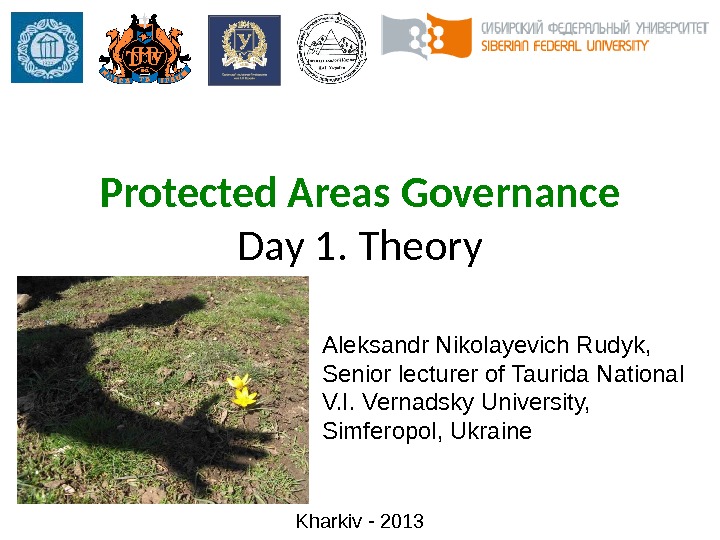
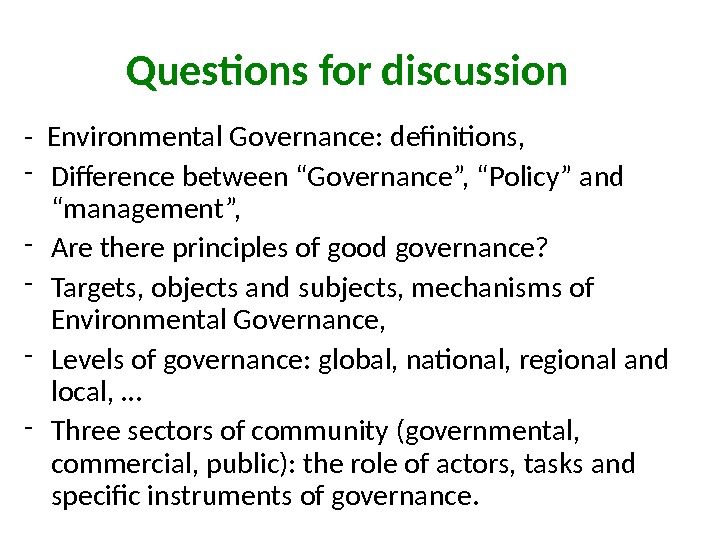
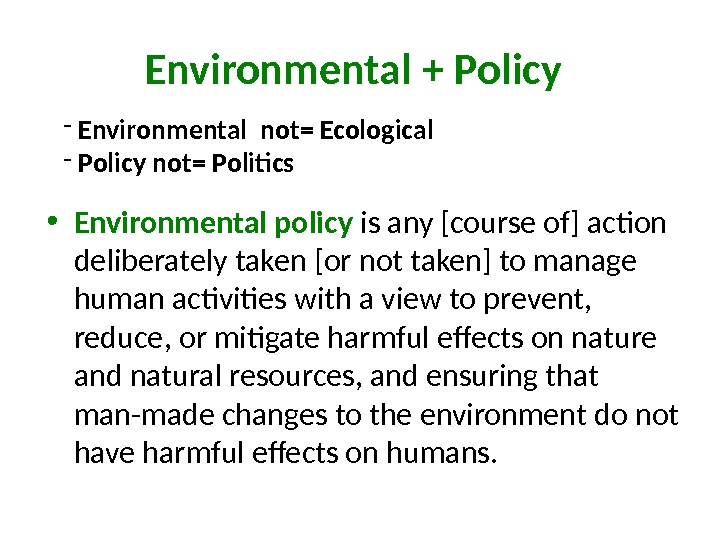
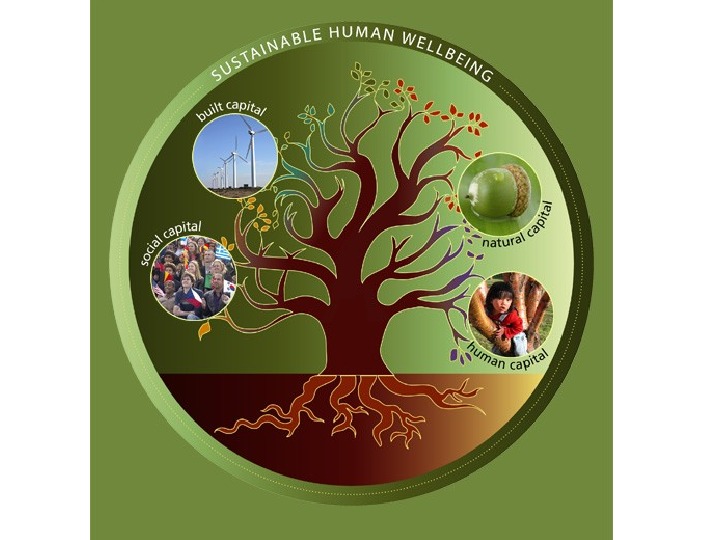

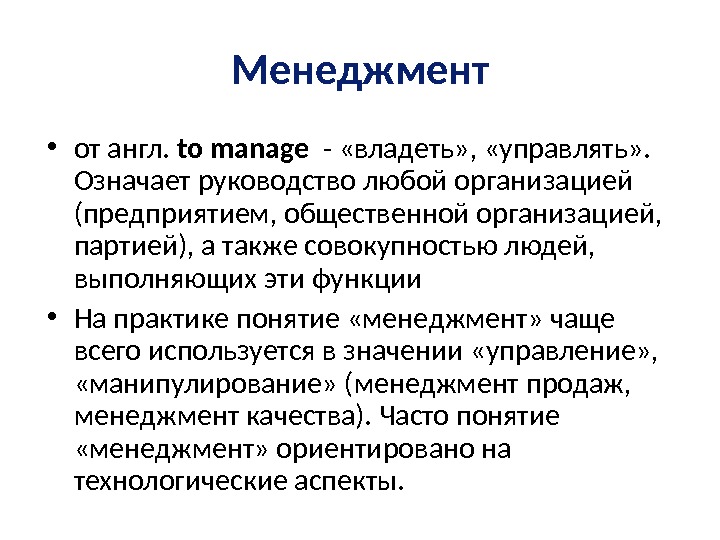
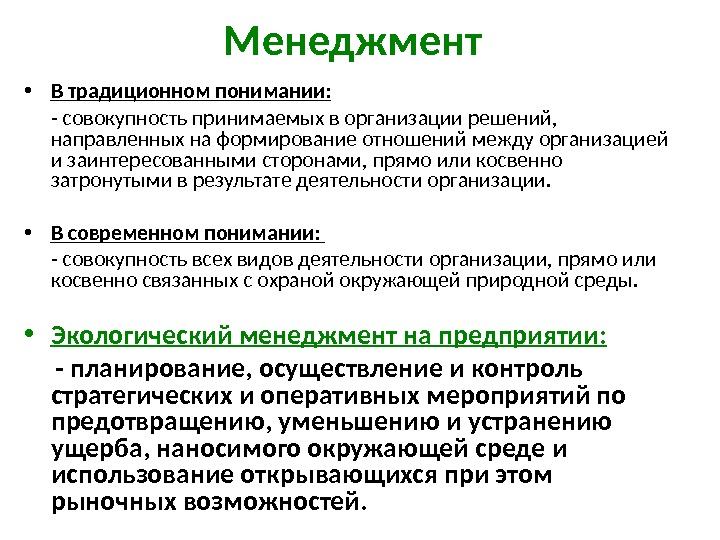

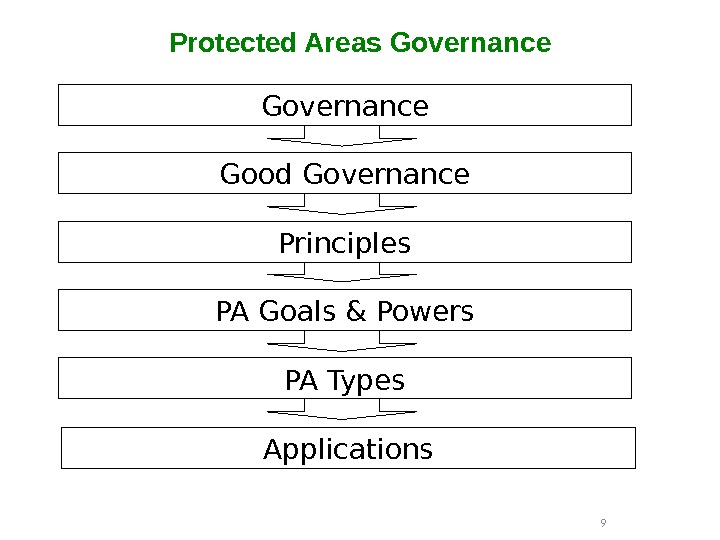
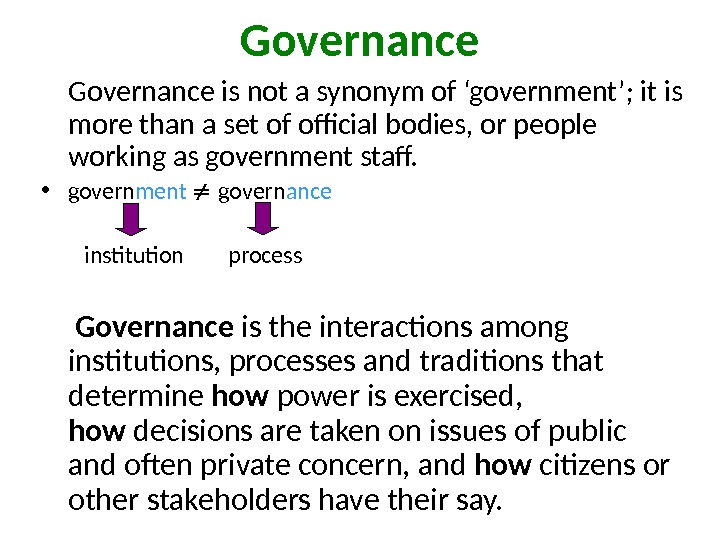
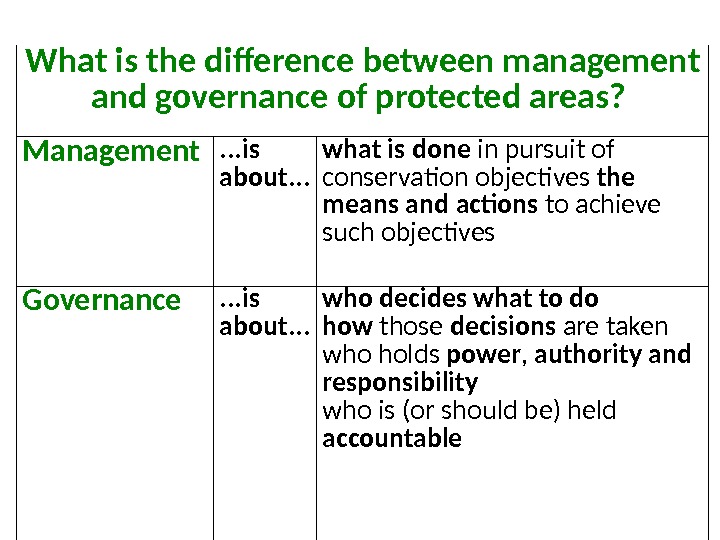
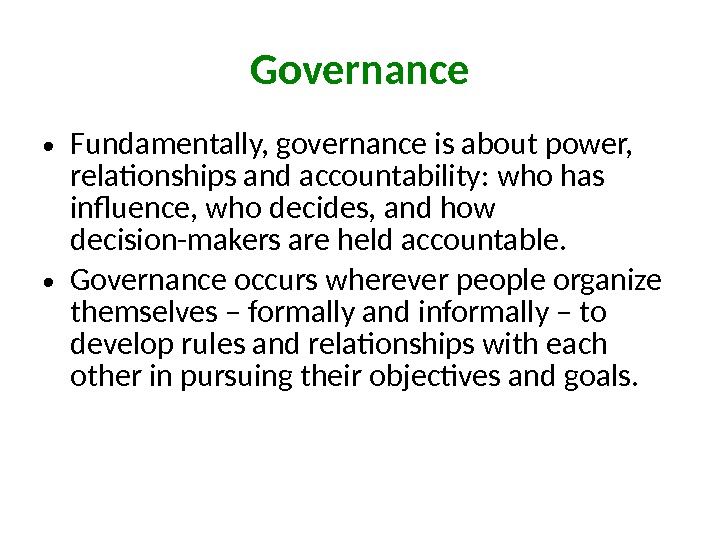
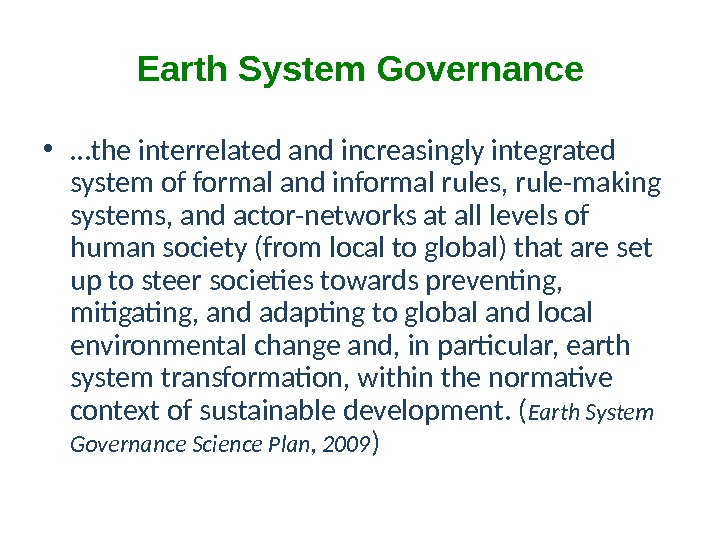
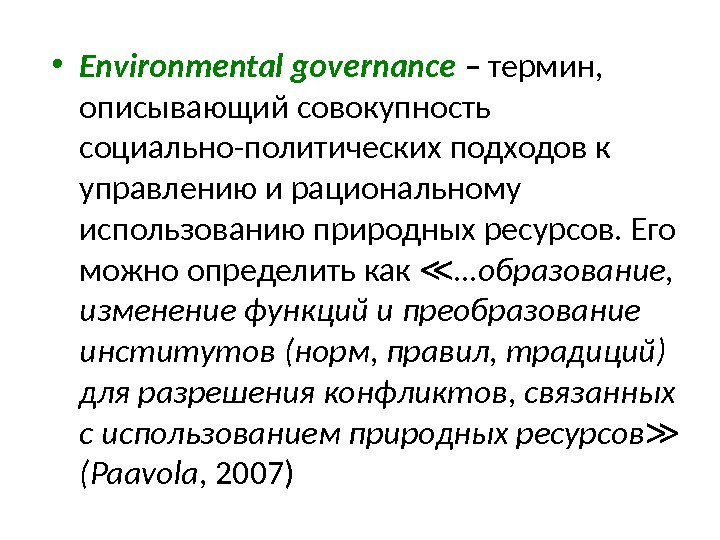
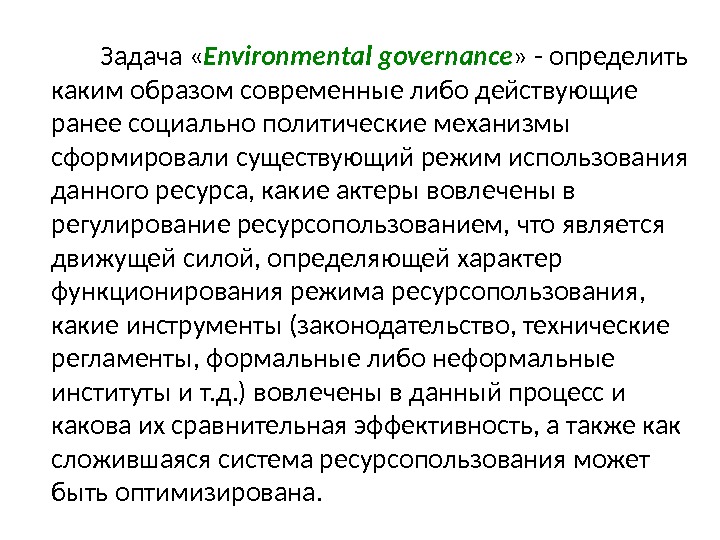
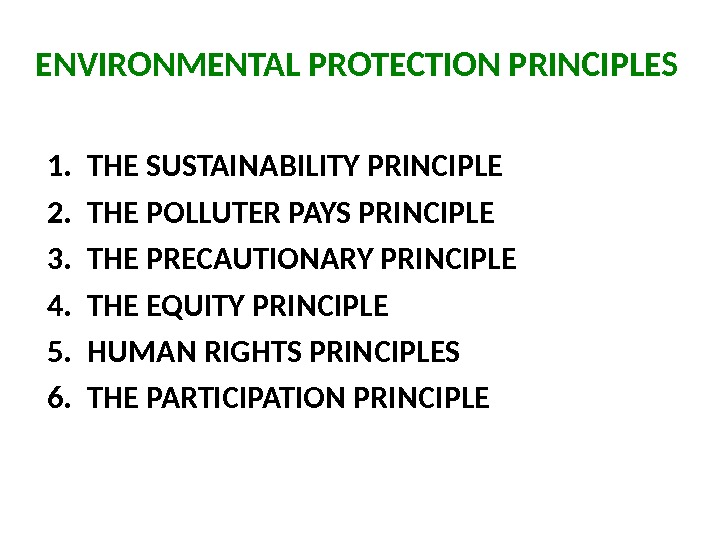
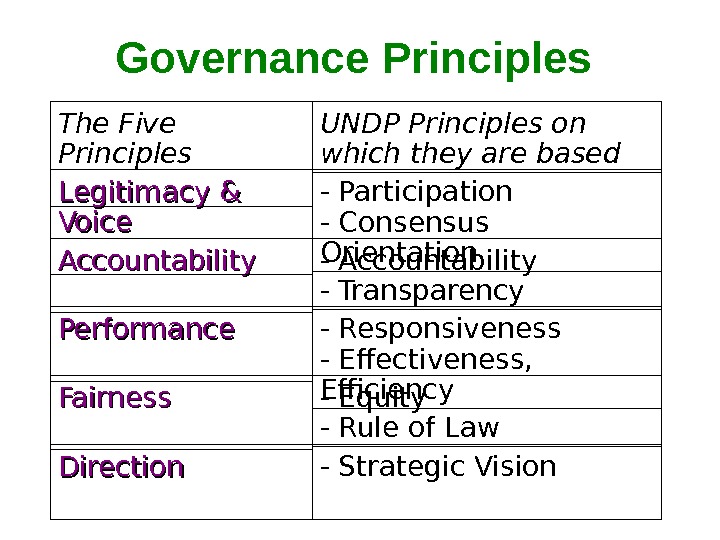
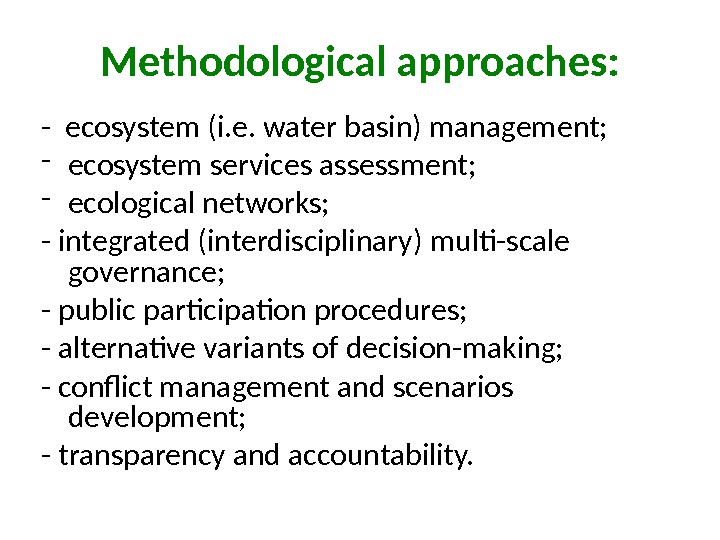
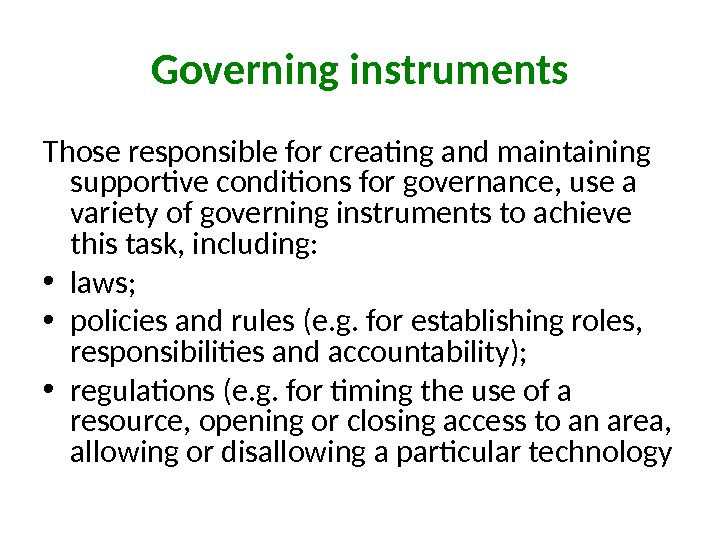
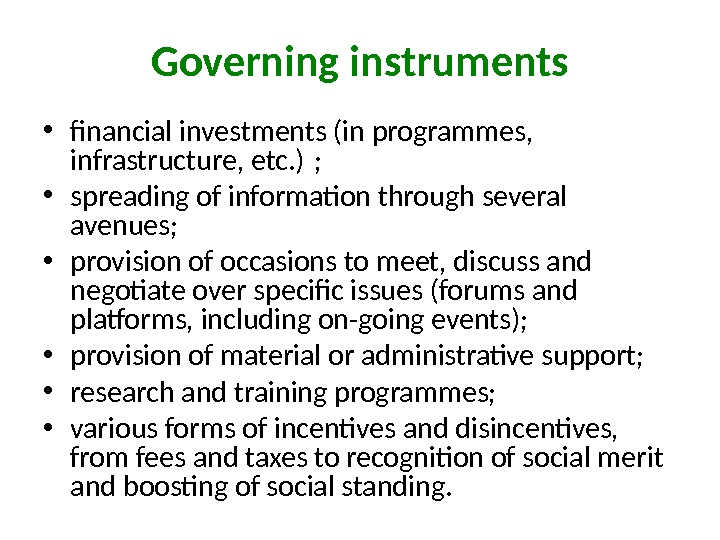

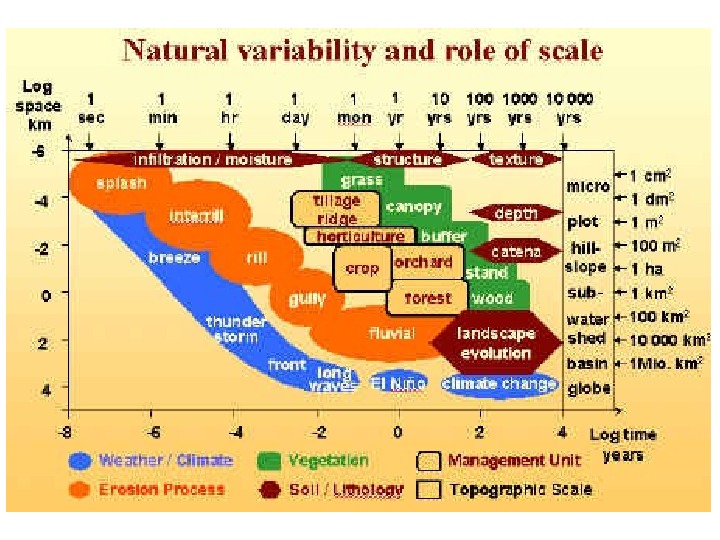
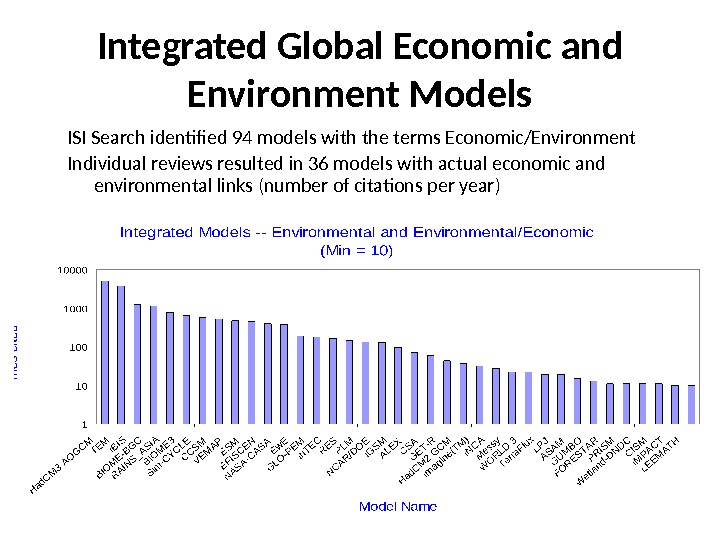

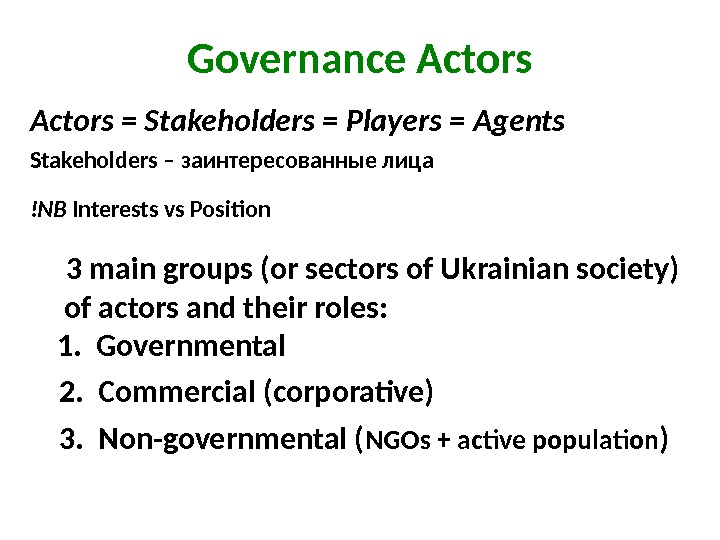
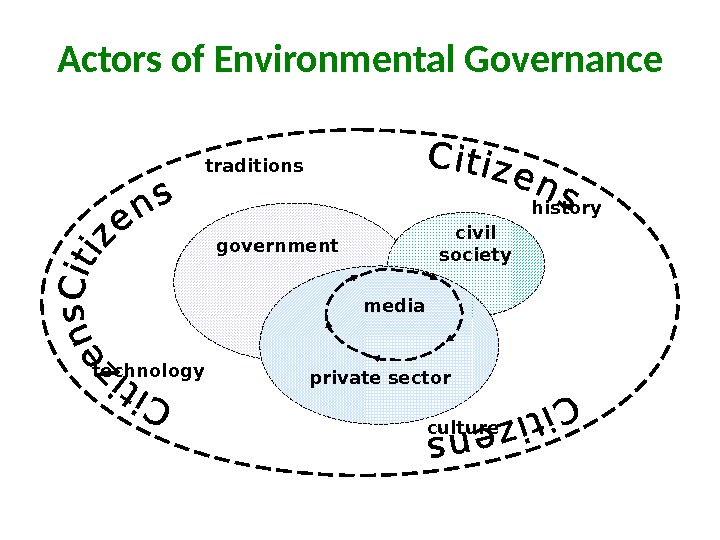

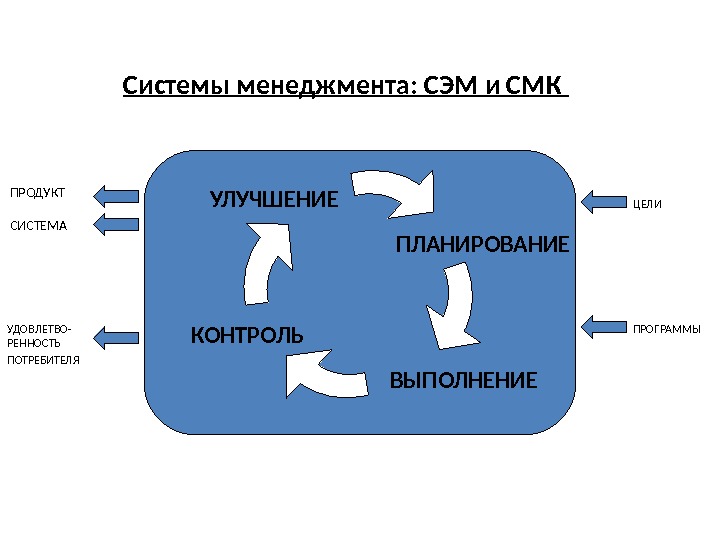
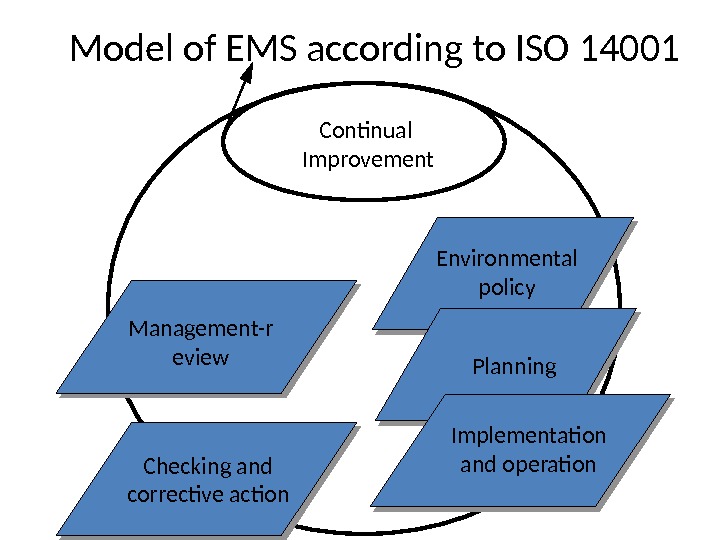
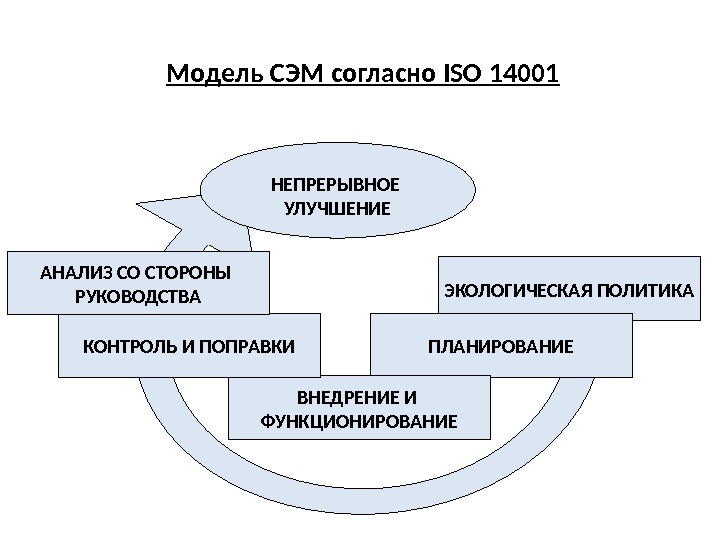
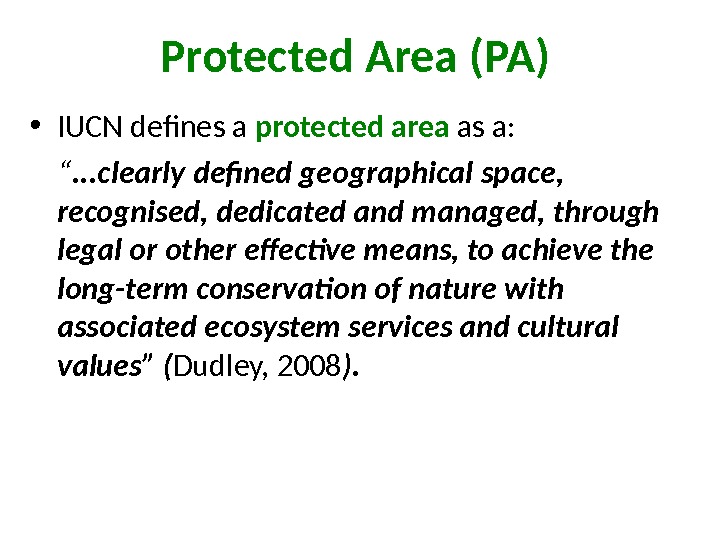
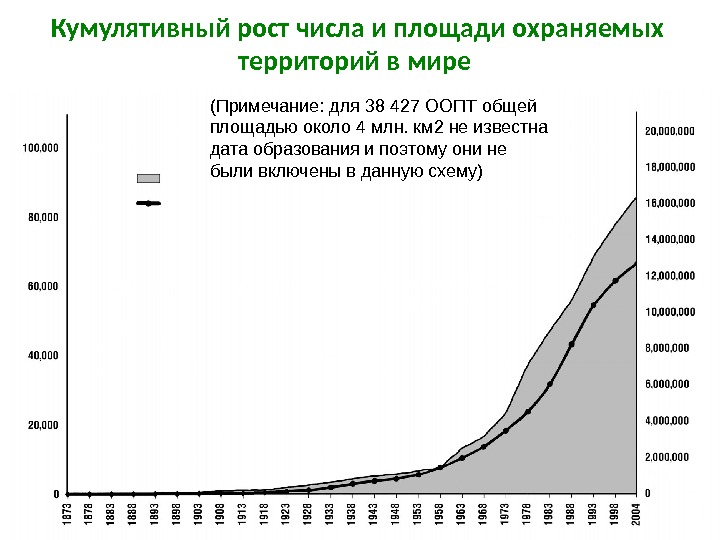
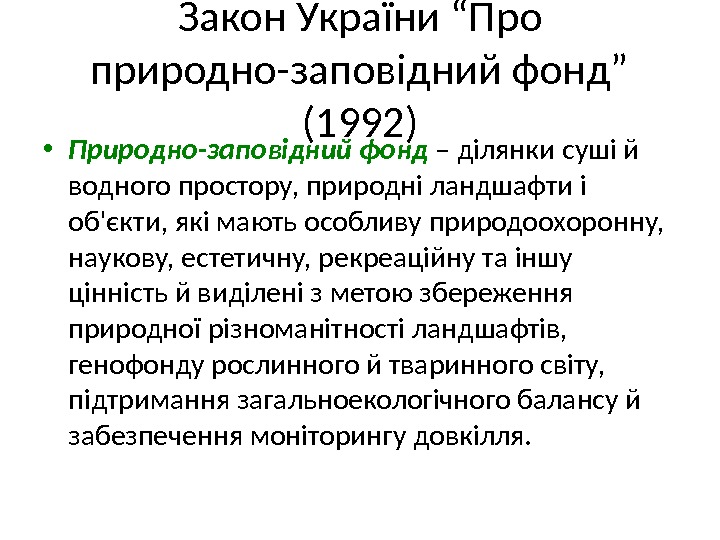

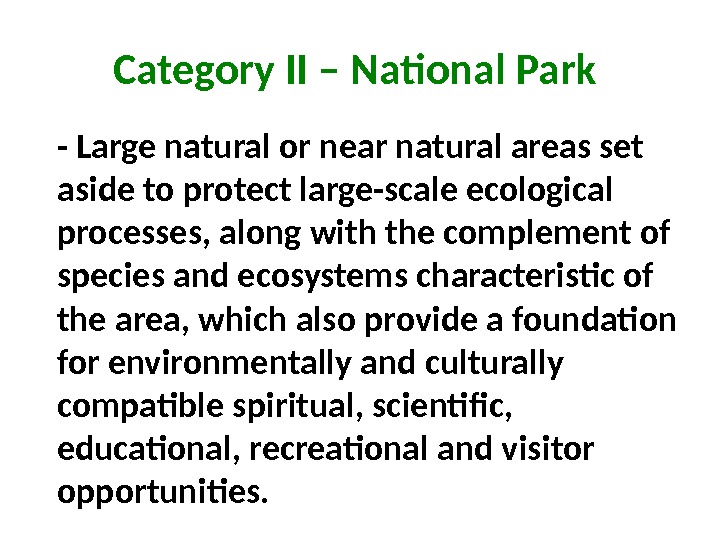
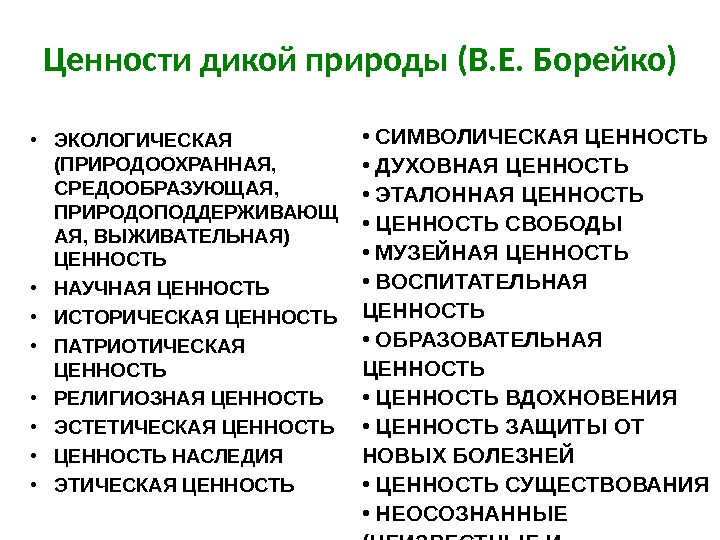
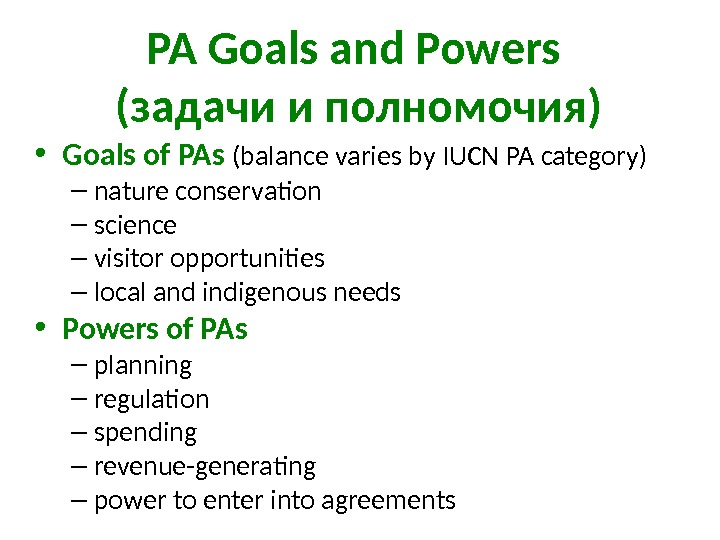

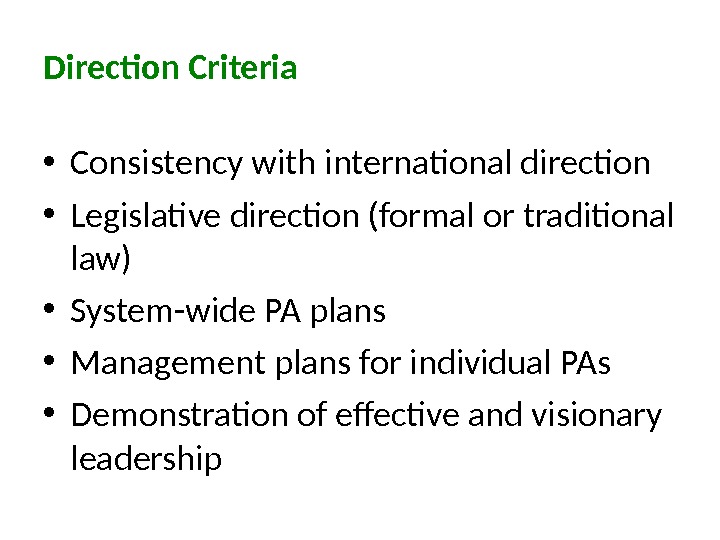
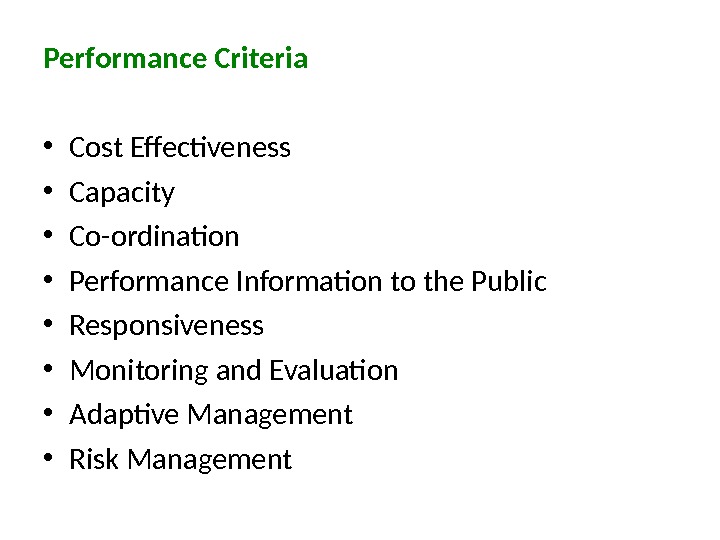
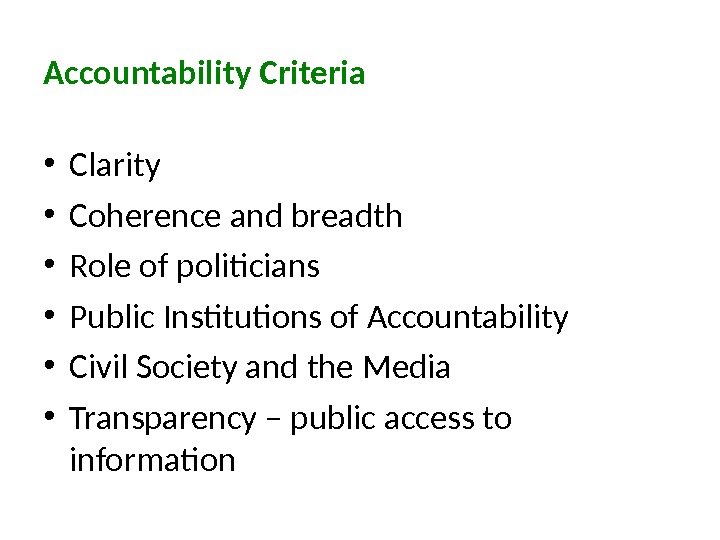
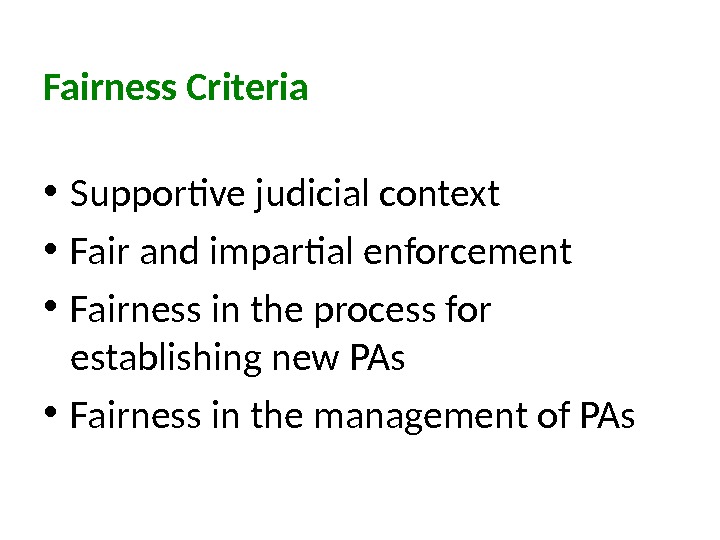
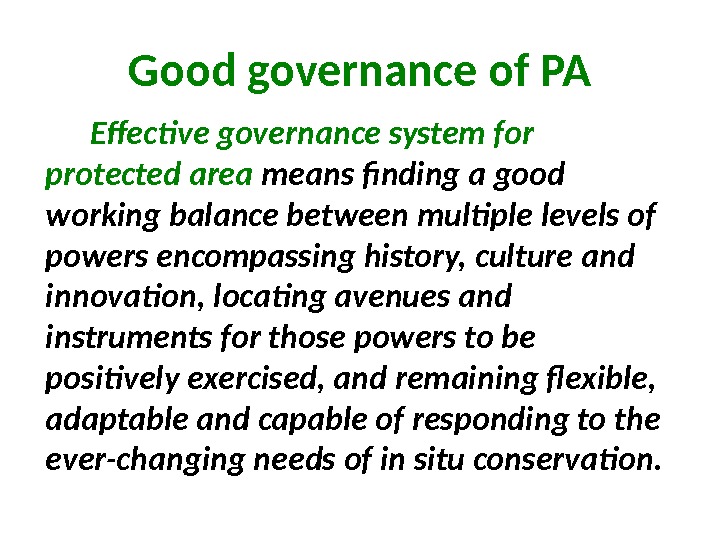
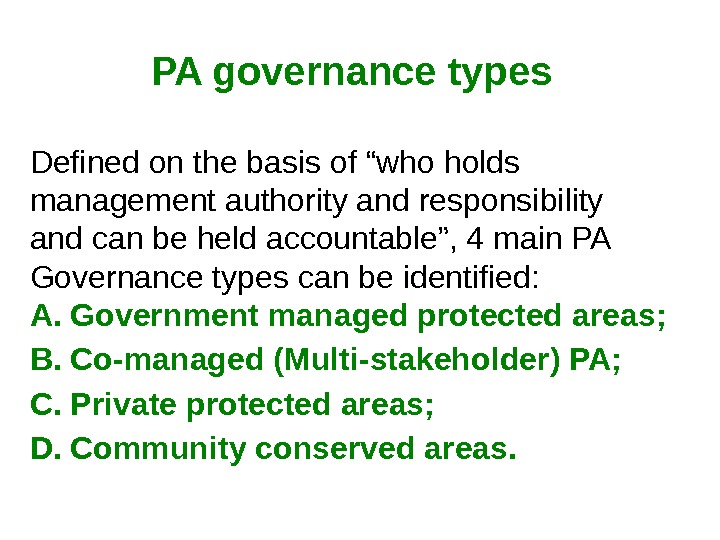
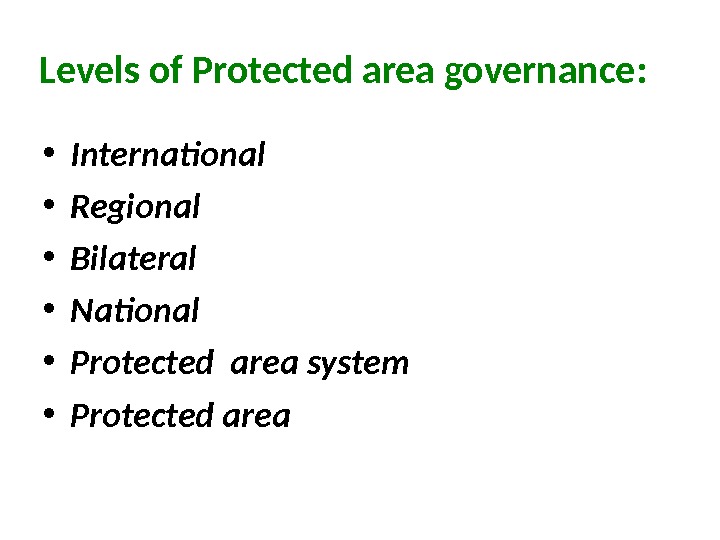
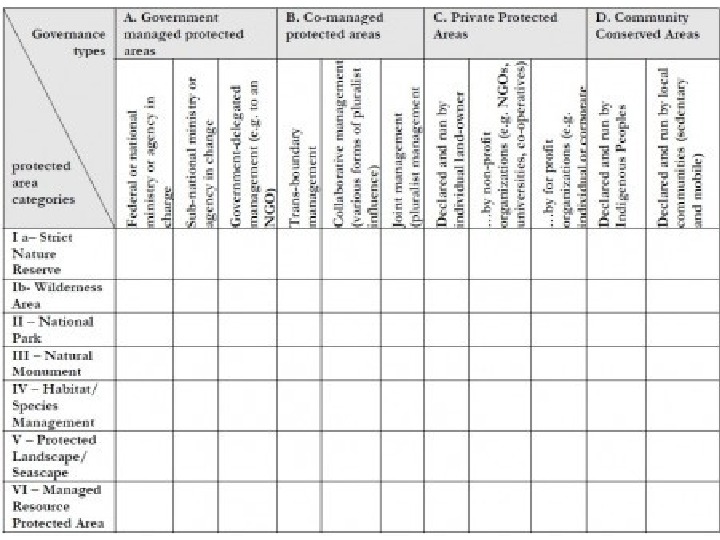
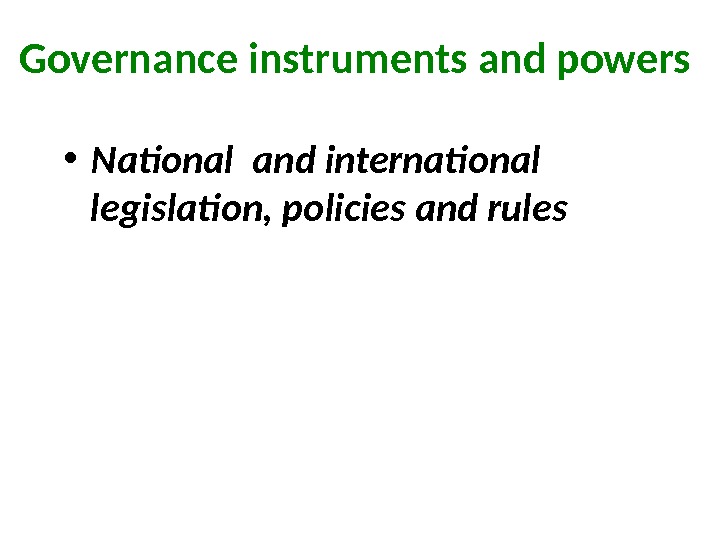
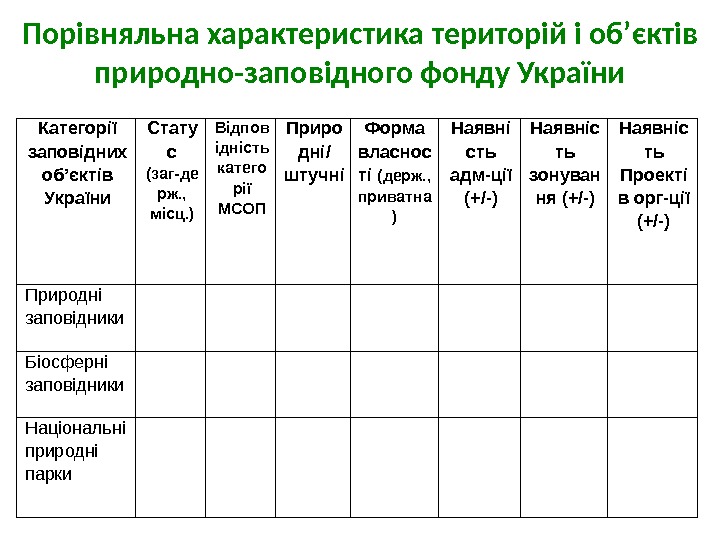
protected_areas_governance-theory-2013.ppt
- Размер: 2 Mегабайта
- Количество слайдов: 48
Описание презентации Protected Areas Governance Day 1. Theory Kharkiv — по слайдам
 Protected Areas Governance Day 1. Theory Kharkiv — 2013 Aleksandr Nikolayevich Rudyk, Senior lecturer of Taurida National V. I. Vernadsky University, Simferopol, Ukraine
Protected Areas Governance Day 1. Theory Kharkiv — 2013 Aleksandr Nikolayevich Rudyk, Senior lecturer of Taurida National V. I. Vernadsky University, Simferopol, Ukraine
 Questions for discussion — Environmental Governance: definitions, — Difference between “Governance”, “Policy” and “management”, — Are there principles of good governance? — Targets, objects and subjects, mechanisms of Environmental Governance, — Levels of governance: global, national, regional and local, … — Three sectors of community (governmental, commercial, public): the role of actors, tasks and specific instruments of governance.
Questions for discussion — Environmental Governance: definitions, — Difference between “Governance”, “Policy” and “management”, — Are there principles of good governance? — Targets, objects and subjects, mechanisms of Environmental Governance, — Levels of governance: global, national, regional and local, … — Three sectors of community (governmental, commercial, public): the role of actors, tasks and specific instruments of governance.
![Environmental + P olicy • Environmental policy is any [course of] action deliberately taken [or Environmental + P olicy • Environmental policy is any [course of] action deliberately taken [or](/docs//protected_areas_governance-theory-2013_images/protected_areas_governance-theory-2013_2.jpg) Environmental + P olicy • Environmental policy is any [course of] action deliberately taken [or not taken] to manage human activities with a view to prevent, reduce, or mitigate harmful effects on nature and natural resources, and ensuring that man-made changes to the environment do not have harmful effects on humans. — Environmental not= Ecological — Policy not= Politics
Environmental + P olicy • Environmental policy is any [course of] action deliberately taken [or not taken] to manage human activities with a view to prevent, reduce, or mitigate harmful effects on nature and natural resources, and ensuring that man-made changes to the environment do not have harmful effects on humans. — Environmental not= Ecological — Policy not= Politics

 Management • Management in all business and organizational activities is the act of getting people together to accomplish desired goals and objectives using available resources efficiently and effectively. • Management comprises planning, organizing, staffing, leading or directing, and controlling an organization (a group of one or more people or entities) or effort for the purpose of accomplishing a goal. Resourcing encompasses the deployment and manipulation of human resources, financial resources, technological resources and natural resources. • Environmental resource management tries to identify the factors that have a stake in the conflicts that may rise between meeting the needs and protecting the resources.
Management • Management in all business and organizational activities is the act of getting people together to accomplish desired goals and objectives using available resources efficiently and effectively. • Management comprises planning, organizing, staffing, leading or directing, and controlling an organization (a group of one or more people or entities) or effort for the purpose of accomplishing a goal. Resourcing encompasses the deployment and manipulation of human resources, financial resources, technological resources and natural resources. • Environmental resource management tries to identify the factors that have a stake in the conflicts that may rise between meeting the needs and protecting the resources.
 Менеджмент • от англ. to manage — «владеть» , «управлять» . Означает руководство любой организацией (предприятием, общественной организацией, партией), а также совокупностью людей, выполняющих эти функции • На практике понятие «менеджмент» чаще всего используется в значении «управление» , «манипулирование» (менеджмент продаж, менеджмент качества). Часто понятие «менеджмент» ориентировано на технологические аспекты.
Менеджмент • от англ. to manage — «владеть» , «управлять» . Означает руководство любой организацией (предприятием, общественной организацией, партией), а также совокупностью людей, выполняющих эти функции • На практике понятие «менеджмент» чаще всего используется в значении «управление» , «манипулирование» (менеджмент продаж, менеджмент качества). Часто понятие «менеджмент» ориентировано на технологические аспекты.
 Менеджмент • В традиционном понимании: — совокупность принимаемых в организации решений, направленных на формирование отношений между организацией и заинтересованными сторонами, прямо или косвенно затронутыми в результате деятельности организации. • В современном понимании: — совокупность всех видов деятельности организации, прямо или косвенно связанных с охраной окружающей природной среды. • Экологический менеджмент на предприятии : — п ланирование, осуществление и контроль стратегических и оперативных мероприятий по предотвращению, уменьшению и устранению ущерба, наносимого окружающей среде и использование открывающихся при этом рыночных возможностей.
Менеджмент • В традиционном понимании: — совокупность принимаемых в организации решений, направленных на формирование отношений между организацией и заинтересованными сторонами, прямо или косвенно затронутыми в результате деятельности организации. • В современном понимании: — совокупность всех видов деятельности организации, прямо или косвенно связанных с охраной окружающей природной среды. • Экологический менеджмент на предприятии : — п ланирование, осуществление и контроль стратегических и оперативных мероприятий по предотвращению, уменьшению и устранению ущерба, наносимого окружающей среде и использование открывающихся при этом рыночных возможностей.
 Interdisciplinary Field of Environmental Management COST ACCOUNTING ENGINEERING STATISTICS ECONOMICS/FINANCE ENVIRONMENT MANAGEMENT ACCOUNTING ENERGY SAVING FINANCIAL ANALYSIS ORGANISATION ENVIRONMENTAL AUDITS
Interdisciplinary Field of Environmental Management COST ACCOUNTING ENGINEERING STATISTICS ECONOMICS/FINANCE ENVIRONMENT MANAGEMENT ACCOUNTING ENERGY SAVING FINANCIAL ANALYSIS ORGANISATION ENVIRONMENTAL AUDITS
 Protected Areas Governance 9 Governance Good Governance Principles PA Goals & Powers PA Types Applications
Protected Areas Governance 9 Governance Good Governance Principles PA Goals & Powers PA Types Applications
 Governance is not a synonym of ‘government’; it is more than a set of official bodies, or people working as government staff. • govern ment govern ance institution process Governance is the interactions among institutions, processes and traditions that determine how power is exercised, how decisions are taken on issues of public and often private concern, and how citizens or other stakeholders have their say.
Governance is not a synonym of ‘government’; it is more than a set of official bodies, or people working as government staff. • govern ment govern ance institution process Governance is the interactions among institutions, processes and traditions that determine how power is exercised, how decisions are taken on issues of public and often private concern, and how citizens or other stakeholders have their say.
 What is the difference between management and governance of protected areas? Management . . . is about. . . what is done in pursuit of conservation objectives the means and actions to achieve such objectives Governance . . . is about. . . who decides what to do how those decisions are taken who holds power , authority and responsibility who is (or should be) held accountable
What is the difference between management and governance of protected areas? Management . . . is about. . . what is done in pursuit of conservation objectives the means and actions to achieve such objectives Governance . . . is about. . . who decides what to do how those decisions are taken who holds power , authority and responsibility who is (or should be) held accountable
 • Fundamentally, governance is about power, relationships and accountability: who has influence, who decides, and how decision-makers are held accountable. • Governance occurs wherever people organize themselves – formally and informally – to develop rules and relationships with each other in pursuing their objectives and goals. Governance
• Fundamentally, governance is about power, relationships and accountability: who has influence, who decides, and how decision-makers are held accountable. • Governance occurs wherever people organize themselves – formally and informally – to develop rules and relationships with each other in pursuing their objectives and goals. Governance
 Earth System Governance • … the interrelated and increasingly integrated system of formal and informal rules, rule-making systems, and actor-networks at all levels of human society (from local to global) that are set up to steer societies towards preventing, mitigating, and adapting to global and local environmental change and, in particular, earth system transformation, within the normative context of sustainable development. ( Earth System Governance Science Plan, 2009 )
Earth System Governance • … the interrelated and increasingly integrated system of formal and informal rules, rule-making systems, and actor-networks at all levels of human society (from local to global) that are set up to steer societies towards preventing, mitigating, and adapting to global and local environmental change and, in particular, earth system transformation, within the normative context of sustainable development. ( Earth System Governance Science Plan, 2009 )
 • Environmental governance – термин, описывающий совокупность социально-политических подходов к управлению и рациональному использованию природных ресурсов. Его можно определить как ≪ …образование, изменение функций и преобразование институтов ( норм, правил, традиций ) для разрешения конфликтов, связанных с использованием природных ресурсов ≫ (Paavola, 2007 )
• Environmental governance – термин, описывающий совокупность социально-политических подходов к управлению и рациональному использованию природных ресурсов. Его можно определить как ≪ …образование, изменение функций и преобразование институтов ( норм, правил, традиций ) для разрешения конфликтов, связанных с использованием природных ресурсов ≫ (Paavola, 2007 )
 Задача « Environmental governance » — определить каким образом современные либо действующие ранее социально политические механизмы сформировали существующий режим использования данного ресурса, какие актеры вовлечены в регулирование ресурсопользованием, что является движущей силой, определяющей характер функционирования режима ресурсопользования, какие инструменты ( законодательство, технические регламенты, формальные либо неформальные институты и т. д. ) вовлечены в данный процесс и какова их сравнительная эффективность, а также как сложившаяся система ресурсопользования может быть оптимизирована.
Задача « Environmental governance » — определить каким образом современные либо действующие ранее социально политические механизмы сформировали существующий режим использования данного ресурса, какие актеры вовлечены в регулирование ресурсопользованием, что является движущей силой, определяющей характер функционирования режима ресурсопользования, какие инструменты ( законодательство, технические регламенты, формальные либо неформальные институты и т. д. ) вовлечены в данный процесс и какова их сравнительная эффективность, а также как сложившаяся система ресурсопользования может быть оптимизирована.
 ENVIRONMENTAL PROTECTION PRINCIPLES 1. THE SUSTAINABILITY PRINCIPLE 2. THE POLLUTER PAYS PRINCIPLE 3. THE PRECAUTIONARY PRINCIPLE 4. THE EQUITY PRINCIPLE 5. HUMAN RIGHTS PRINCIPLES 6. THE PARTICIPATION PRINCIPL
ENVIRONMENTAL PROTECTION PRINCIPLES 1. THE SUSTAINABILITY PRINCIPLE 2. THE POLLUTER PAYS PRINCIPLE 3. THE PRECAUTIONARY PRINCIPLE 4. THE EQUITY PRINCIPLE 5. HUMAN RIGHTS PRINCIPLES 6. THE PARTICIPATION PRINCIPL
 Governance Principles The Five Principles Accountability Performance Fairness Direction Legitimacy & Voice UNDP Principles on which they are based — Participation — Consensus Orientation — Accountability — Transparency — Responsiveness — Effectiveness, Efficiency — Equity — Rule of Law — Strategic Vision
Governance Principles The Five Principles Accountability Performance Fairness Direction Legitimacy & Voice UNDP Principles on which they are based — Participation — Consensus Orientation — Accountability — Transparency — Responsiveness — Effectiveness, Efficiency — Equity — Rule of Law — Strategic Vision
 Methodological approaches: — ecosystem (i. e. water basin) management; — ecosystem services assessment; — ecological networks; — integrated (interdisciplinary) multi-scale governance; — public participation procedures; — alternative variants of decision-making; — conflict management and scenarios development; — transparency and accountability.
Methodological approaches: — ecosystem (i. e. water basin) management; — ecosystem services assessment; — ecological networks; — integrated (interdisciplinary) multi-scale governance; — public participation procedures; — alternative variants of decision-making; — conflict management and scenarios development; — transparency and accountability.
 Governing instruments Those responsible for creating and maintaining supportive conditions for governance, use a variety of governing instruments to achieve this task, including: • laws; • policies and rules (e. g. for establishing roles, responsibilities and accountability); • regulations (e. g. for timing the use of a resource, opening or closing access to an area, allowing or disallowing a particular technology
Governing instruments Those responsible for creating and maintaining supportive conditions for governance, use a variety of governing instruments to achieve this task, including: • laws; • policies and rules (e. g. for establishing roles, responsibilities and accountability); • regulations (e. g. for timing the use of a resource, opening or closing access to an area, allowing or disallowing a particular technology
 • financial investments (in programmes, infrastructure, etc. ) ; • spreading of information through several avenues; • provision of occasions to meet, discuss and negotiate over specific issues (forums and platforms, including on-going events); • provision of material or administrative support; • research and training programmes; • various forms of incentives and disincentives, from fees and taxes to recognition of social merit and boosting of social standing. Governing instruments
• financial investments (in programmes, infrastructure, etc. ) ; • spreading of information through several avenues; • provision of occasions to meet, discuss and negotiate over specific issues (forums and platforms, including on-going events); • provision of material or administrative support; • research and training programmes; • various forms of incentives and disincentives, from fees and taxes to recognition of social merit and boosting of social standing. Governing instruments
 Scales of Governance — Spatial scales • Global assessment • National policies • Programs of municipalities • Rationale for individuals — Temporal scales • Immediate impacts • Long term impacts • Life cycle assessment
Scales of Governance — Spatial scales • Global assessment • National policies • Programs of municipalities • Rationale for individuals — Temporal scales • Immediate impacts • Long term impacts • Life cycle assessment

 Integrated Global Economic and Environment Models ISI Search identified 94 models with the terms Economic/Environment Individual reviews resulted in 36 models with actual economic and environmental links (number of citations per year)
Integrated Global Economic and Environment Models ISI Search identified 94 models with the terms Economic/Environment Individual reviews resulted in 36 models with actual economic and environmental links (number of citations per year)
 The types of actors involved can be many and varied, including government agencies and ministries at various levels, local elected and traditional authorities, local communities, NGOs, businesses and corporations, international bodies, labour unions, professional organizations, religious and educational organizations, military authorities, political officials and parties, etc. Governance actors
The types of actors involved can be many and varied, including government agencies and ministries at various levels, local elected and traditional authorities, local communities, NGOs, businesses and corporations, international bodies, labour unions, professional organizations, religious and educational organizations, military authorities, political officials and parties, etc. Governance actors
 Governance Actors = Stakeholders = Players = Agents Stakeholders – заинтересованные лица !NB Interests vs Position 3 main groups (or sectors of Ukrainian society) of actors and their roles: 1. Governmental 2. Commercial (corporative) 3. Non-governmental ( NGOs + active population )
Governance Actors = Stakeholders = Players = Agents Stakeholders – заинтересованные лица !NB Interests vs Position 3 main groups (or sectors of Ukrainian society) of actors and their roles: 1. Governmental 2. Commercial (corporative) 3. Non-governmental ( NGOs + active population )
 Actors of Environmental Governance mediagovernment civil society private sectortraditions culturetechnology history
Actors of Environmental Governance mediagovernment civil society private sectortraditions culturetechnology history
 “ Deming’s Wheel” модель c истемы менеджмента: Plan Do Check Act
“ Deming’s Wheel” модель c истемы менеджмента: Plan Do Check Act
 Системы менеджмента: СЭМ и СМК ПЛАНИРОВАНИЕ ВЫПОЛНЕНИЕКОНТРОЛЬ УЛУЧШЕНИЕПРОДУКТ СИСТЕМА УДОВЛЕТВО- РЕННОСТЬ ПОТРЕБИТЕЛЯ ПРОГРАММЫ ЦЕЛИ
Системы менеджмента: СЭМ и СМК ПЛАНИРОВАНИЕ ВЫПОЛНЕНИЕКОНТРОЛЬ УЛУЧШЕНИЕПРОДУКТ СИСТЕМА УДОВЛЕТВО- РЕННОСТЬ ПОТРЕБИТЕЛЯ ПРОГРАММЫ ЦЕЛИ
 Model of EMS according to ISO 14001 Continual Improvement Management-r eview Checking and corrective action Implementation and operation Planning. Environmental policy
Model of EMS according to ISO 14001 Continual Improvement Management-r eview Checking and corrective action Implementation and operation Planning. Environmental policy
 Модель СЭМ согласно ISO 14001 ЭКОЛОГИЧЕСКАЯ ПОЛИТИКА ПЛАНИРОВАНИЕ ВНЕДРЕНИЕ И ФУНКЦИОНИРОВАНИЕКОНТРОЛЬ И ПОПРАВКИАНАЛИЗ СО СТОРОНЫ РУКОВОДСТВА НЕПРЕРЫВНОЕ УЛУЧШЕНИЕ
Модель СЭМ согласно ISO 14001 ЭКОЛОГИЧЕСКАЯ ПОЛИТИКА ПЛАНИРОВАНИЕ ВНЕДРЕНИЕ И ФУНКЦИОНИРОВАНИЕКОНТРОЛЬ И ПОПРАВКИАНАЛИЗ СО СТОРОНЫ РУКОВОДСТВА НЕПРЕРЫВНОЕ УЛУЧШЕНИЕ
 Protected Area (PA) • IUCN defines a protected area as a: “. . . clearly defined geographical space, recognised, dedicated and managed, through legal or other effective means, to achieve the long-term conservation of nature with associated ecosystem services and cultural values” ( Dudley, 2008 ).
Protected Area (PA) • IUCN defines a protected area as a: “. . . clearly defined geographical space, recognised, dedicated and managed, through legal or other effective means, to achieve the long-term conservation of nature with associated ecosystem services and cultural values” ( Dudley, 2008 ).
 Кумулятивный рост числа и площади охраняемых территорий в мире (Примечание: для 38 427 ООПТ общей площадью около 4 млн. км 2 не известна дата образования и поэтому они не были включены в данную схему)
Кумулятивный рост числа и площади охраняемых территорий в мире (Примечание: для 38 427 ООПТ общей площадью около 4 млн. км 2 не известна дата образования и поэтому они не были включены в данную схему)
 Закон Укр аїни “Про природно-заповідний фонд” (1992) • Природно-заповідний фонд – ділянки суші й водного простору, природні ландшафти і об’єкти, які мають особливу природоохоронну, наукову, естетичну, рекреаційну та іншу цінність й виділені з метою збереження природної різноманітності ландшафтів, генофонду рослинного й тваринного світу, підтримання загальноекологічного балансу й забезпечення моніторингу довкілля.
Закон Укр аїни “Про природно-заповідний фонд” (1992) • Природно-заповідний фонд – ділянки суші й водного простору, природні ландшафти і об’єкти, які мають особливу природоохоронну, наукову, естетичну, рекреаційну та іншу цінність й виділені з метою збереження природної різноманітності ландшафтів, генофонду рослинного й тваринного світу, підтримання загальноекологічного балансу й забезпечення моніторингу довкілля.
 IUCN protected area management categories Ia — Strict Nature Reserve Ib – Wilderness areas II – National Park (ecosystem protection; protection of cultural values) III – Natural Monument IV – Habitat/ Species Management V – Protected Landscape/ Seascape VI – Managed Resource
IUCN protected area management categories Ia — Strict Nature Reserve Ib – Wilderness areas II – National Park (ecosystem protection; protection of cultural values) III – Natural Monument IV – Habitat/ Species Management V – Protected Landscape/ Seascape VI – Managed Resource
 Category II – National Park — Large natural or near natural areas set aside to protect large-scale ecological processes, along with the complement of species and ecosystems characteristic of the area, which also provide a foundation for environmentally and culturally compatible spiritual, scientific, educational, recreational and visitor opportunities.
Category II – National Park — Large natural or near natural areas set aside to protect large-scale ecological processes, along with the complement of species and ecosystems characteristic of the area, which also provide a foundation for environmentally and culturally compatible spiritual, scientific, educational, recreational and visitor opportunities.
 Ценности дикой природы (В. Е. Борейко) • ЭКОЛОГИЧЕСКАЯ (ПРИРОДООХРАННАЯ, СРЕДООБРАЗУЮЩАЯ, ПРИРОДОПОДДЕРЖИВАЮЩ АЯ, ВЫЖИВАТЕЛЬНАЯ) ЦЕННОСТЬ • НАУЧНАЯ ЦЕННОСТЬ • ИСТОРИЧЕСКАЯ ЦЕННОСТЬ • ПАТРИОТИЧЕСКАЯ ЦЕННОСТЬ • РЕЛИГИОЗНАЯ ЦЕННОСТЬ • ЭСТЕТИЧЕСКАЯ ЦЕННОСТЬ • ЦЕННОСТЬ НАСЛЕДИЯ • ЭТИЧЕСКАЯ ЦЕННОСТЬ • СИМВОЛИЧЕСКАЯ ЦЕННОСТЬ • ДУХОВНАЯ ЦЕННОСТЬ • ЭТАЛОННАЯ ЦЕННОСТЬ • ЦЕННОСТЬ СВОБОДЫ • МУЗЕЙНАЯ ЦЕННОСТЬ • ВОСПИТАТЕЛЬНАЯ ЦЕННОСТЬ • ОБРАЗОВАТЕЛЬНАЯ ЦЕННОСТЬ • ЦЕННОСТЬ ВДОХНОВЕНИЯ • ЦЕННОСТЬ ЗАЩИТЫ ОТ НОВЫХ БОЛЕЗНЕЙ • ЦЕННОСТЬ СУЩЕСТВОВАНИЯ • НЕОСОЗНАННЫЕ (НЕИЗВЕСТНЫЕ И НЕРАЗРАБОТАННЫЕ) ЦЕННОСТИ
Ценности дикой природы (В. Е. Борейко) • ЭКОЛОГИЧЕСКАЯ (ПРИРОДООХРАННАЯ, СРЕДООБРАЗУЮЩАЯ, ПРИРОДОПОДДЕРЖИВАЮЩ АЯ, ВЫЖИВАТЕЛЬНАЯ) ЦЕННОСТЬ • НАУЧНАЯ ЦЕННОСТЬ • ИСТОРИЧЕСКАЯ ЦЕННОСТЬ • ПАТРИОТИЧЕСКАЯ ЦЕННОСТЬ • РЕЛИГИОЗНАЯ ЦЕННОСТЬ • ЭСТЕТИЧЕСКАЯ ЦЕННОСТЬ • ЦЕННОСТЬ НАСЛЕДИЯ • ЭТИЧЕСКАЯ ЦЕННОСТЬ • СИМВОЛИЧЕСКАЯ ЦЕННОСТЬ • ДУХОВНАЯ ЦЕННОСТЬ • ЭТАЛОННАЯ ЦЕННОСТЬ • ЦЕННОСТЬ СВОБОДЫ • МУЗЕЙНАЯ ЦЕННОСТЬ • ВОСПИТАТЕЛЬНАЯ ЦЕННОСТЬ • ОБРАЗОВАТЕЛЬНАЯ ЦЕННОСТЬ • ЦЕННОСТЬ ВДОХНОВЕНИЯ • ЦЕННОСТЬ ЗАЩИТЫ ОТ НОВЫХ БОЛЕЗНЕЙ • ЦЕННОСТЬ СУЩЕСТВОВАНИЯ • НЕОСОЗНАННЫЕ (НЕИЗВЕСТНЫЕ И НЕРАЗРАБОТАННЫЕ) ЦЕННОСТИ
 • Goals of PAs (balance varies by IUCN PA category) – nature conservation – science – visitor opportunities – local and indigenous needs • Powers of PAs – planning – regulation – spending – revenue-generating – power to enter into agreements PA Goals and Powers (задачи и полномочия)
• Goals of PAs (balance varies by IUCN PA category) – nature conservation – science – visitor opportunities – local and indigenous needs • Powers of PAs – planning – regulation – spending – revenue-generating – power to enter into agreements PA Goals and Powers (задачи и полномочия)
 Legitimacy and Voice Criteria • Supportive democratic and human rights context • Decentralization in decision-making • Collaborative management • Citizen participation at all levels of decision-making • Civil society groups and an independent media • High levels of trust
Legitimacy and Voice Criteria • Supportive democratic and human rights context • Decentralization in decision-making • Collaborative management • Citizen participation at all levels of decision-making • Civil society groups and an independent media • High levels of trust
 Direction Criteria • Consistency with international direction • Legislative direction (formal or traditional law) • System-wide PA plans • Management plans for individual PAs • Demonstration of effective and visionary leadership
Direction Criteria • Consistency with international direction • Legislative direction (formal or traditional law) • System-wide PA plans • Management plans for individual PAs • Demonstration of effective and visionary leadership
 Performance Criteria • Cost Effectiveness • Capacity • Co-ordination • Performance Information to the Public • Responsiveness • Monitoring and Evaluation • Adaptive Management • Risk Management
Performance Criteria • Cost Effectiveness • Capacity • Co-ordination • Performance Information to the Public • Responsiveness • Monitoring and Evaluation • Adaptive Management • Risk Management
 Accountability Criteria • Clarity • Coherence and breadth • Role of politicians • Public Institutions of Accountability • Civil Society and the Media • Transparency – public access to information
Accountability Criteria • Clarity • Coherence and breadth • Role of politicians • Public Institutions of Accountability • Civil Society and the Media • Transparency – public access to information
 Fairness Criteria • Supportive judicial context • Fair and impartial enforcement • Fairness in the process for establishing new PAs • Fairness in the management of PAs
Fairness Criteria • Supportive judicial context • Fair and impartial enforcement • Fairness in the process for establishing new PAs • Fairness in the management of PAs
 Good governance of PA Effective governance system for protected area means finding a good working balance between multiple levels of powers encompassing history, culture and innovation, locating avenues and instruments for those powers to be positively exercised, and remaining flexible, adaptable and capable of responding to the ever-changing needs of in situ conservation.
Good governance of PA Effective governance system for protected area means finding a good working balance between multiple levels of powers encompassing history, culture and innovation, locating avenues and instruments for those powers to be positively exercised, and remaining flexible, adaptable and capable of responding to the ever-changing needs of in situ conservation.
 PA governance types Defined on the basis of “who holds management authority and responsibility and can be held accountable”, 4 main PA Governance types can be identified: A. Government managed protected areas; B. Co-managed ( Multi-stakeholder ) PA; C. Private protected areas; D. Community conserved areas.
PA governance types Defined on the basis of “who holds management authority and responsibility and can be held accountable”, 4 main PA Governance types can be identified: A. Government managed protected areas; B. Co-managed ( Multi-stakeholder ) PA; C. Private protected areas; D. Community conserved areas.
 Levels of Protected area governance: • International • Regional • Bilateral • National • Protected area system • Protected area
Levels of Protected area governance: • International • Regional • Bilateral • National • Protected area system • Protected area

 Governance instruments and powers • National and international legislation, policies and rules
Governance instruments and powers • National and international legislation, policies and rules
 Порівняльна характеристика територій і об’єктів природно-заповідного фонду України Категорії заповідних об’єктів України Стату с (заг-де рж. , м ісц. ) Відпов ідність катего рії МСОП Приро дні / штучні Форма власнос ті (держ. , приватна ) Наявні сть адм-ції (+/-) Наявніс ть зонуван ня (+/-) Наявніс ть Проекті в орг-ції (+/-) Природні заповідники Біосферні заповідники Національні природні парки
Порівняльна характеристика територій і об’єктів природно-заповідного фонду України Категорії заповідних об’єктів України Стату с (заг-де рж. , м ісц. ) Відпов ідність катего рії МСОП Приро дні / штучні Форма власнос ті (держ. , приватна ) Наявні сть адм-ції (+/-) Наявніс ть зонуван ня (+/-) Наявніс ть Проекті в орг-ції (+/-) Природні заповідники Біосферні заповідники Національні природні парки
